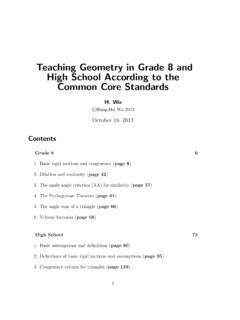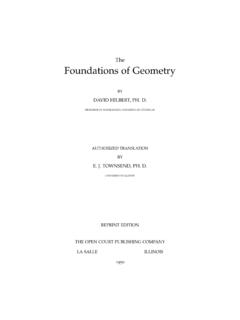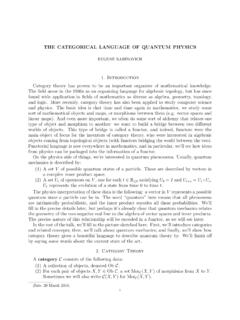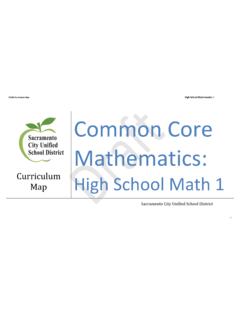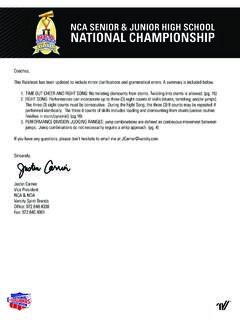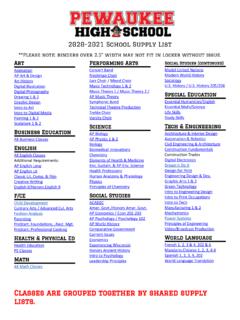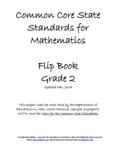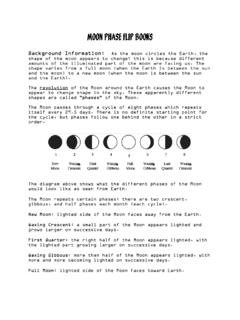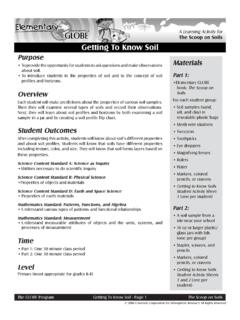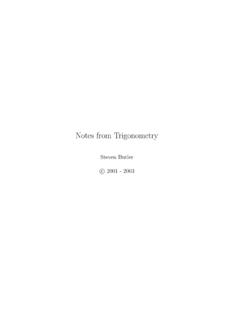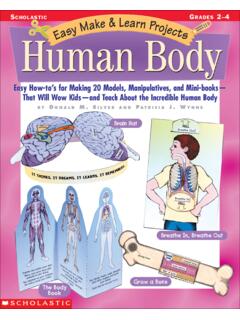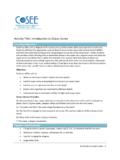Transcription of Teaching Geometry According to the Common Core Standards
1 Teaching Geometry According to theCommon Core StandardsH. Wuc Hung-Hsi Wu 2013 January 1, revision: October 10, 47 Grade 519 Grade 631 Grade 747 Grade 862 high school Geometry1101 PrefaceLe juge:Accus e, vous t acherez d etre accus e:Je t acherai d etre clair. G. Courteline1 This document is a collection of grade-by-grade mathematical commentaries onthe Teaching of the Geometry Standards in theCCSSM( Common Core State Stan-dards for Mathematics) from grade 4 to high school . The emphasis is on theprogres-sion of the mathematical ideasthrough the grades. It complements the usual writingsand discussions on the CCSSM which emphasize the latter s Practice Standards . Itis hoped that this document will promote a better understanding of the PracticeStandards by giving themmathematicalsubstance rather than adding to theverbaldescriptions of what mathematics is about.
2 Seeing (correct) mathematics in actionis a far better way of coming to grips with these Practice Standards but, unfortu-nately, in an era ofTextbook school Mathematics (TSM),2one does not get tosee mathematics in action too often. Mathematicians should have done much moreto reveal the true nature of mathematics, but they didn t, and school mathematicseducation is the worse for it. Let us hope that, with the advent of the CCSSM, moreof such efforts will be Geometry Standards in the CCSSM deviate from the usual Geometry standardsin at least two respects, one big and one small. The small one is that, for the firsttime, special attention is paid to the need of a proof for the area formula for rectangleswhen the side lengths arefractions.
3 This is standard NF 4b in grade 5:Find the area of a rectangle with fractional side lengths by tiling it with [rect-angles] of the appropriate unit fraction side lengths, and show that the areais the same as would be found by multiplying the side lengths. Multiply frac-tional side lengths to find areas of rectangles, and represent fraction productsas rectangular in the classic,Commutative Algebra, of Zariski-Samuel. Literal translation: The judge: The defendant will try to be brief. The defendant replies, I will try to be clear. 2A turquoise box around a phrase or a sentence (such as Textbook school Mathematics ) indicatesan active link to an article lack of explanation for the rectangle area formula when the side lengths arefractions is symptomatic of what has gone wrong in school mathematics education, ormore precisely, in TSM.
4 Often basic facts are not clearly explained, or if explained, itis done incorrectly. Because the explanation in this case requires a full understandingof fraction multiplication and the basic ingredients of the concept ofarea(see (a) (d)on page 21 ), and because the reasoning is far from routine and yet very accessible tofifth graders, this explanation is potentially a high point in students encounter withgeometric measurements (length, area, volume) in K 12. Let us make sure that it isso this time major deviation of the CCSSM from the usual Geometry Standards occursin grade 8 and high school . There is at present an almost total disconnect inTSM between the Geometry of middle school and that of high school .
5 Congruenceand similarity are (vaguely!) defined in middle school as same-size-and-same-shape and same-shape-but-not-necessarily-same-size , respectively, while middle- school ge-ometric transformations (rotations, reflections, and translations) are taught seeminglyonly for the purpose of art appreciation, such as appreciating the internal symmetriesof Escher s famous designs and medieval Islamic art without any reference to theirmathematical the high school Geometry of TSM, congruence and similarity are defined anew( , ASA, SSS, etc.) butonlyfor polygons, thereby creating the impression thatmathematical precision can be achieved only for polygons. As for geometric trans-formations, well, they are relegated to the end of the year as an enhancement of theconcepts of congruence,if time goes without saying that such a disconnect is not acceptable mathematics edu-cation.
6 In contrast, there is a seamless transition from the Geometry of grade 8 to highschool Geometry in the CCSSM. The concepts of rotation, reflection, translation, anddilation taught in grade 8 basically on an intuitive level become the foundation forthe mathematical development of the high school Geometry course. In the process,students get to see, perhaps for the first time, themathematicalsignificance of rota-tion, reflection, translation, and dilation as well as the precise meaning of congruenceand similarity. Thus the latter are no longer seen to be some abstract and shadowyconcepts but are, rather, concepts open to tactile investigations. In addition, it is onlythrough the precise definition of congruence as a composition of rotations, reflections,3and translations that students can begin to make sense of what is known in TSM as CPCTC (corresponding parts of congruent triangles are congruent).
7 Many have expressed reservations about the CCSSM Geometry Standards . Becauserotation, reflection, translation, and dilation are now used for a serious mathematicalpurpose, there is a perception that so-called transformational Geometry (whateverthat means) rules the CCSSM Geometry curriculum. Transformational Geometry isperceived to be something quaint and faddish not to say incomprehensible to truth is that the school Geometry curriculum in TSM has been dysfunctionalfor far too long and the needed restructuring is way overdue. The new course chartedby the CCSSM will be seen to be not only mathematically defensible but also aconservative one, in the sense that it does not inject any new topics into the standardcurriculum.
8 Its main innovation lies in nothing more than exhibitingnew connectionsamong the existing topics to clarify their mathematical it be notedexplicitly thatthe CCSSM do not pursue transformational Geometry per transformations are merely a means to an end: they are used in a strictlyutilitarian way to streamline and shed light on the existing school Geometry curricu-lum. For example, once reflections, rotations, reflections, and dilations have con-tributed to the proofs of the standard triangle congruence and similarity criteria(SAS, SSS, etc.), the development of plane Geometry can proceed in the usual way ifone so the moment, the introductory portion of such a development of Geometry canbe found, in greater detail than is given in this article, in Chapters 4 7 of H.
9 Wu,Pre-Algebra. In fact, this approach to school Geometry has been taught to teachers inthree-week professional development institutes since 2004, and the document H. Wu,Pre-Algebra is nothing but a set of lecture notes from these institutes. This set ofnotes is referenced on page 92 of the CCSSM, but under a different title:Wu, H., Lecture Notes for the 2009 Pre-Algebra Institute, September 15, completely revised version of these notes will appear as part a textbook for middleschool mathematics teachers:H. Wu,From Pre-Algebra to Algebra, to appear in , a complete account of this treatment of school Geometry will appear(probably in 2015) as part of a two-volume textbook for high school teachers:H. Wu,Mathematics of the Secondary school Curriculum, I and the meantime, please see page 150 and page 154 for further comments on this logical relationship between reflections, rotations, etc.
10 , on the one hand andcongruence and similarity on the other in plane Geometry , while completely routineto working geometers, is mostly unknown to teachers and mathematics educators be-cause mathematicians have been negligent in sharing their knowledge. A successfulimplementation of the CCSSM therefore requires a massive national effort to teachmathematics to inservice and preservice teachers. To the extent that such an effortdoes not seem to be forthcoming as of October 2013, I am posting this document on-line in order to make a reasonably detailed account of this knowledge freely this mathematical restructuring of school Geometry by the CCSSM can bebacked up by a strong commitment to the professional development of teachers, thereis no reason to doubt that greater student achievement would reader will note that the present commentaries avoid the pitfall of most ex-isting materials that treat school Geometry as an exercise in learning new vocabularyor memorizing new formulas.
